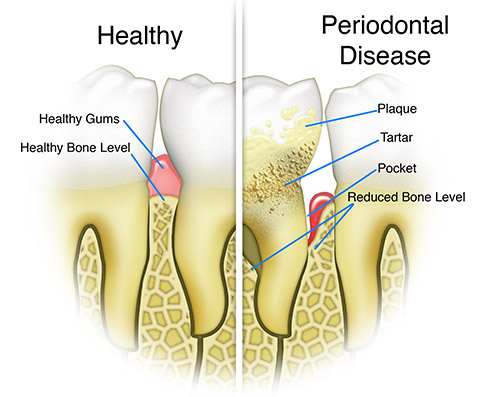Non-Surgical Periodontics
 Periodontal disease, also known as gum disease, is a common inflammatory condition which affects the soft tissue surrounding the tooth, and even the jawbone itself it its most advance stages. It occurs when toxins of plaque build-up irritate and inflame the gum tissues (gingivitis), colonizing in the gum pockets between the teeth. There it is difficult to remove and treat. For this reason, periodontal disease is a progressive condition, and if left untreated, it can lead to shifting teeth and tooth loss. In fact, periodontal disease is the leading cause of adult tooth loss in the developed world.
Periodontal disease, also known as gum disease, is a common inflammatory condition which affects the soft tissue surrounding the tooth, and even the jawbone itself it its most advance stages. It occurs when toxins of plaque build-up irritate and inflame the gum tissues (gingivitis), colonizing in the gum pockets between the teeth. There it is difficult to remove and treat. For this reason, periodontal disease is a progressive condition, and if left untreated, it can lead to shifting teeth and tooth loss. In fact, periodontal disease is the leading cause of adult tooth loss in the developed world.
Diagnosis
Periodontal disease is diagnosed by your dentist or dental hygienist during a periodontal examination. This type of exam should always be part of your regular dental check-up.
A periodontal probe (small dental instrument) is gently used to measure the sulcus (pocket or space) between the tooth and the gums. The depth of a healthy sulcus measures three millimeters or less and does not bleed. The periodontal probe helps indicate if pockets are deeper than three millimeters. As periodontal disease progresses, the pockets usually get deeper.
Your dentist or hygienist will use pocket depths, amount of bleeding, inflammation, tooth mobility, etc., to make a diagnosis that will fall into a category below:
Gingivitis
Gingivitis is the first stage of periodontal disease. Plaque and its toxin by-products irritate the gums, making them tender, inflamed, and likely to bleed.
Periodontitis
Plaque hardens into calculus (tartar). As calculus and plaque continue to build up, the gums begin to recede from the teeth. Deeper pockets form between the gums and teeth and become filled with bacteria and pus. The gums become very irritated, inflamed, and bleed easily. Slight to moderate bone loss may be present.
Advanced Periodontitis
The teeth lose more support as the gums, bone, and periodontal ligament continue to be destroyed. Unless treated, the affected teeth will become very loose and may be lost. Generalized moderate to severe bone loss may be present.


